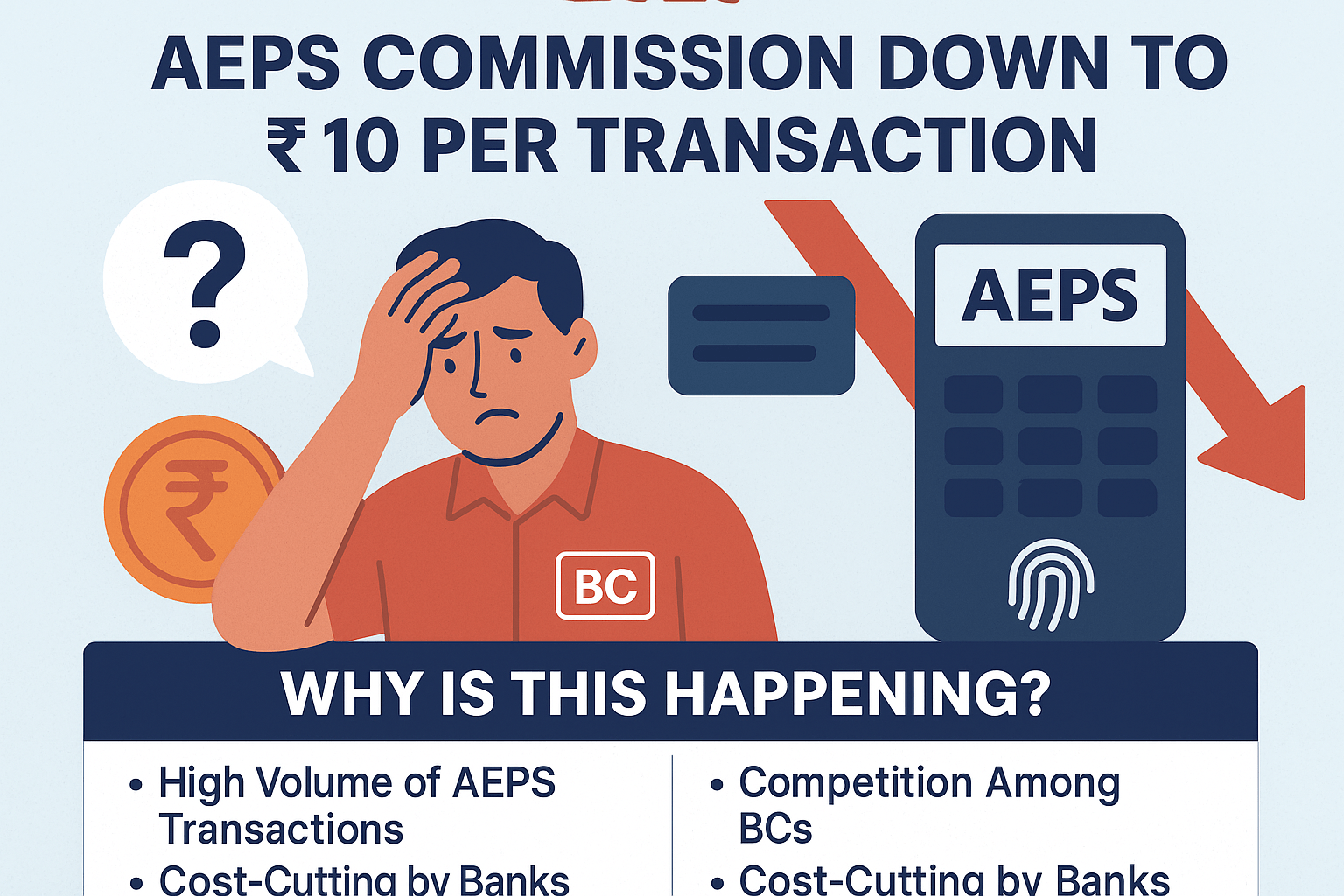Aadhaar Enabled Payment System (AEPS) has been a game-changer in (AEPS commission) India’s digital banking landscape, enabling millions to access cashless transactions. However, a surprising trend has emerged in 2025—AEPS commission, which was once a lucrative revenue stream for banking correspondents (BCs), has plummeted to as low as ₹10 per transaction. But why is this happening? What factors are driving this decline, and what does it mean for the future of AEPS?
In this in-depth report, we’ll explore the key reasons behind the falling AEPS commission, analyze market trends, and discuss what stakeholders can expect moving forward.
Understanding AEPS and Its Commission Structure
Before diving into the decline, let’s briefly recap how AEPS commissions work.
-
AEPS (Aadhaar Enabled Payment System) allows users to perform basic banking transactions (cash withdrawal, balance inquiry, mini statements) using their Aadhaar number and biometric authentication.
-
Banking Correspondents (BCs) act as intermediaries, facilitating these transactions in rural and semi-urban areas where bank branches are scarce.
-
Commission Structure: BCs earn a small fee per transaction, which was traditionally between ₹15 to ₹30 depending on the bank and transaction type.
However, in 2025, this commission has drastically reduced to ₹10 or even lower in some cases. Let’s break down the reasons.

Key Reasons Behind the Falling AEPS Commission
1. Increased Competition Among BCs & Fintech Players
The AEPS ecosystem has seen a massive influx of banking correspondents and fintech companies. With more players entering the market, banks have reduced commissions to cut costs.
-
Example: Major players like PayNearby, Eko, and Fino Payments Bank have expanded aggressively, leading to a supply-demand imbalance.
-
Result: Banks no longer need to offer high commissions as BCs are willing to operate at lower margins.
2. Government & RBI Push for Lower Transaction Costs
The Reserve Bank of India (RBI) and the government have been advocating for affordable digital transactions to promote financial inclusion.
-
Policy Influence: RBI’s guidelines encourage banks to minimize charges on small-value transactions.
-
Direct Benefit Transfer (DBT) Impact: Since many subsidies are disbursed via AEPS, keeping transaction costs low ensures beneficiaries aren’t burdened.
3. Shift Towards UPI & Other Digital Payment Modes
The rise of UPI (Unified Payments Interface) has reduced reliance on AEPS for small transactions.
-
UPI’s Zero MDR Policy: Unlike AEPS, UPI transactions attract no merchant fees, making them more attractive.
-
Consumer Preference: Users now prefer scanning QR codes over biometric authentication for faster transactions.
4. Cost Optimization by Banks
Banks are under pressure to reduce operational expenses, and AEPS commissions are an easy target.
-
Automation & Reduced Manual Work: Improved AEPS infrastructure means fewer failed transactions, reducing the need for high BC commissions.
-
Bulk Transaction Discounts: Banks negotiate lower rates with BCs handling high volumes.
5. Fraud & Security Concerns Leading to Stricter Regulations
AEPS has faced rising fraud cases, including biometric spoofing and unauthorized transactions.
-
Increased KYC & Compliance Costs: Banks now invest more in fraud prevention, leading to reduced payouts to BCs.
-
Lower Trust in AEPS: Some users are shifting to more secure alternatives, reducing transaction volumes.
Impact of Falling AEPS Commission on Stakeholders
| Stakeholder | Impact |
|---|---|
| Banking Correspondents (BCs) | Reduced earnings, leading to lower profitability. Many BCs may exit the business. |
| Banks | Lower operational costs but risk losing BC network in remote areas. |
| Customers | Cheaper transactions but may face reduced BC availability. |
| Fintech Companies | Need to innovate with hybrid models (AEPS + UPI + other services). |
Future Outlook: Will AEPS Commission Recover?
While the AEPS commission drop to ₹10 seems concerning, the system isn’t going away anytime soon. Here’s what to expect:
-
Consolidation in BC Market: Only large players with high volumes will survive.
-
Hybrid Payment Models: Fintech firms may bundle AEPS with other services to maintain profitability.
-
Government Intervention: If BCs start exiting, RBI may introduce minimum commission safeguards.

Frequently Asked Questions (FAQs)
1. Why did AEPS commissions drop to ₹10?
Increased competition, RBI’s push for low-cost banking, and the rise of UPI have all contributed to the decline.
2. Will AEPS commissions increase again?
Unlikely in the short term unless RBI mandates a minimum fee structure.
3. How are BCs coping with lower commissions?
Many are diversifying into other financial services like insurance, loans, and UPI-based transactions.
4. Is AEPS still relevant in 2025?
Yes, especially in rural areas where UPI penetration is still growing.
5. What alternatives do BCs have?
Switching to multi-service models (AEPS + micro-ATM + bill payments) can help sustain earnings.
Conclusion
The fall of AEPS commission to ₹10 reflects broader shifts in India’s digital payment ecosystem—rising competition, regulatory pressures, and changing consumer preferences. While this trend poses challenges for banking correspondents, it also pushes the industry toward innovation and efficiency.
For now, stakeholders must adapt by diversifying revenue streams and leveraging technology to stay relevant. The future of AEPS will depend on how well it integrates with newer payment systems while maintaining its core utility for India’s unbanked population.
Disclaimer
This article is for educational purposes only. The views expressed are based on market trends and available data as of 2025. If you have any concerns regarding this content, please refer to our DMCA page for post-removal guidelines. Always verify information with official sources before making financial decisions.
